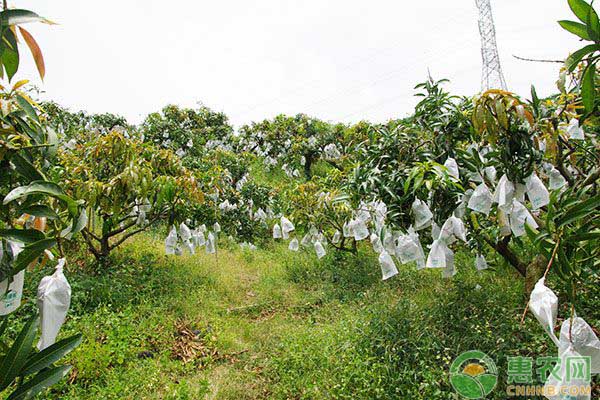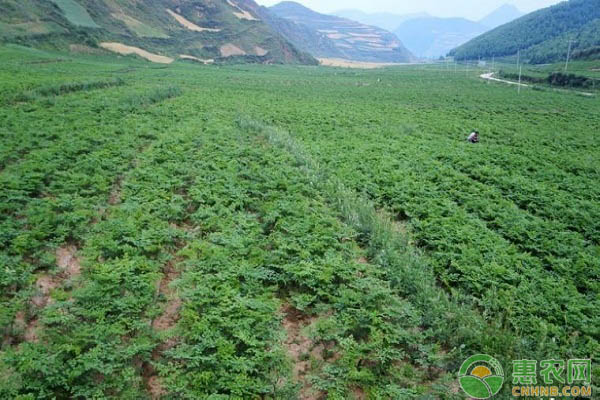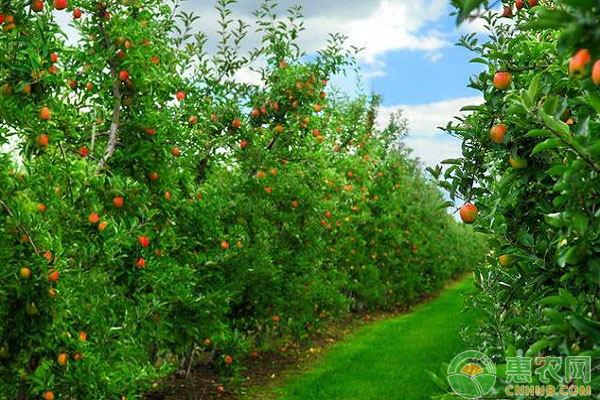At present, many fruit farmers in order to make full use of environmental resources, to obtain more benefits, especially in young orchards, it is necessary to carry out orchard intercropping or interplanting. And this article is mainly for everyone to talk about the main points of the Chinese herbal medicine in the orchard. This intercropping mode actually has a certain scientific basis, mainly because the fruit trees are tall and have deep roots, which can occupy the upper space of the ground and utilize the deep soil nutrition and water. Crops are relatively short and can take advantage of near-surface space and shallow soil nutrients and moisture. In this way, the two complement each other, so it has become a particularly popular business model. Orchard is intercropped, which has many obvious advantages, such as improving the ecological environment and promoting ecological balance. It can increase the coverage of orchard vegetation and enhance the transpiration of plants, especially the fruit trees absorb the deep water of the soil, transpiration into the field and then add Windproof and Moisturizing effect, etc. Therefore, people are constantly exploring and exploring the mode of intercropping of fruit, fruit, fruit, fruit and fruit. However, the interplanting of other crops in the orchard is not something that can be planted casually, because if it is not done, it will affect each other, resulting in losses that are not worth the loss. For example, planting high-crop crops in young orchards can affect the lighting of fruit trees, or some crops and fruit trees interplanting, which will cause frequent occurrence of pests and diseases, or some special substances secreted by crops will affect the nutrient absorption of fruit trees. . Therefore, if you want to interplant in the orchard, you really have to understand it. Recently, I heard people say that "there are many pests that come to the fruit trees, and they don't dare to come." Their specific statement is because the herbs can release some special odors, so that the pests do not dare to come to the orchard. For example, inoculation of Zhimu in jujube gardens will effectively reduce the occurrence of jujube and jujube mosquitoes. Indeed, some orchards can actually control pests after planting appropriate Chinese herbal medicines. However, we still have to say that if the breeding is unreasonable, let alone pest control, it may bring a lot of pests and diseases, causing losses to the orchard. Therefore, in order to interplant Chinese herbal medicines in the orchard, it is necessary to master some principles. According to the actual conditions of the medicines and orchards, according to local conditions and reasonable arrangements, don't “smash the sesame seeds and lose the watermelonâ€. Therefore, we should master the principles of these aspects: First, according to the biological characteristics of different fruit trees and Chinese herbal medicines, constitute a reasonable field structure. For example, the selected Chinese medicinal materials should be mainly resistant to negative and shallow roots; secondly, the proportion should be appropriate, and the fruit trees should be the main ones, and the advantages should be complementary; the third is to interplant the local special and authentic medicinal materials; the fourth is to strengthen the field management. Mutual benefit and mutual benefit, ensuring a double harvest of fruit and medicine. Specifically, what kind of medicinal materials and how to achieve the same effect can be considered from the following aspects: 1. Determine the potted herbs according to the type of orchard. Orchards are dry land, wetlands, mountainous areas, etc. The environment of each type of orchard soil, climate and so on are not the same, so it is necessary to determine the varieties of intercropping according to different types of orchards. For example, dryland orchards are only suitable for planting drought-tolerant medicinal materials, such as Bupleurum, Astragalus, Astragalus, and Zhimu. For wet orchards, they can be planted with Yuanhu, Aconite, and Northern Sand Ginseng, which are moist and not cold-resistant. It is suitable for chlorosis, Codonopsis, Ophiopogon japonicus, Panax notoginseng, American ginseng, etc. 2. Select the planting variety according to the phenological period of the fruit tree. For example, jujube trees, persimmon trees and other late-growing fruit trees can be planted in the orchard, but also in the orchard before the arrival of the hottest month, but the peach, apricot, cherry, and medlar are ripe. It can be used to plant fungi such as cockroaches that are hot and fearful of trampling. It can also use the moisturizing and shading of the crown to produce fungus and white fungus. 3. Select the planting variety according to the age of the fruit tree. Fruit trees are young and mature, and fruit trees of every age group have certain characteristics. Therefore, it is necessary to select appropriate medicinal materials at different ages. In general, young fruit trees can reasonably interplant the varieties of Chinese medicinal materials with low stems, small plant type and small Xiyang, which can reduce the loss of soil nutrients, inhibit the growth of weeds and increase the income. Such as platycodon, Banlangen, dandelion, honeysuckle, saffron and so on. A relatively shady environment has been formed in the row spacing of adult fruit trees. In this case, appropriate varieties of medicinal materials should be selected. Such as Tianma, Huanglian, Sanqi, ginseng, piglets, ganoderma lucidum and saffron. However, most Chinese medicinal materials are not resistant to continuous cropping. Therefore, it is necessary to change the cultivars every year or every other year, and choose the sputum that is suitable for growing medicinal materials. 4. Select the planting variety according to the crown condition of the fruit tree. Canopy and thicker fruit trees, such as peaches, cherries, apricots, grapes, persimmons, etc., can be planted in Pinellia, Tianma, Ganoderma lucidum, Coptis and other medicinal materials. Fruit trees with sparse canopy, such as apples, pears, hawthorns, etc., can be planted with Danshen, Lily, Asparagus and other slightly damp-resistant herbs. In short, the choice of Chinese herbal medicines in the orchard requires that Chinese herbal medicines and fruit trees should not compete for water and fertilizer, and that the growth of the medicinal materials should not cause damage to the fruit trees. The selected medicinal materials must be able to adapt to local conditions to prevent the medicinal materials. Climate conditions, soil conditions do not adapt to the phenomenon of growth and so on. At the same time, it is necessary to pay attention to the medicinal materials, while not affecting the fruit trees, it can also have a certain market advantage, and it can bring good benefits, which can truly achieve the goal of “short-term growthâ€. Cosmetics are compound mixtures made from various raw materials after reasonable blending and processing. There are many types of cosmetics raw materials with different properties. According to the raw material properties and uses of cosmetics, it can be roughly divided into two categories: base raw materials and auxiliary raw materials. The former is a main raw material of cosmetics, which occupies a large proportion in cosmetic formulations, and is the main functional substance in cosmetics. The latter is responsible for shaping, stabilizing or imparting color, fragrance and other characteristics to cosmetics. These substances are not used in large amounts in cosmetic formulations, but are extremely important. Cosmetics are chemical mixtures made of natural, synthetic or extracted substances with different functions as raw materials and processed through production processes such as heating, stirring and emulsification. Collagen peptide, Arbutin, Coenzyme Q10, GSH, Cosmetic Raw Materials, lipoic acid Xi'an Gawen Biotechnology Co., Ltd , https://www.ahualyn-bios.com

